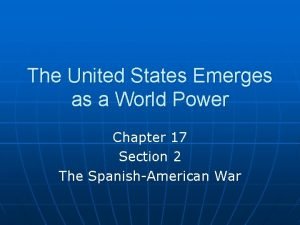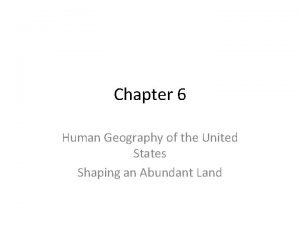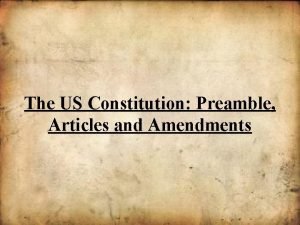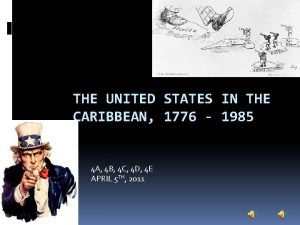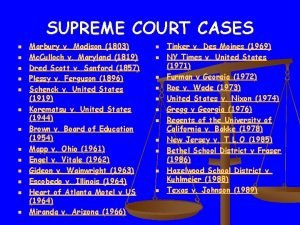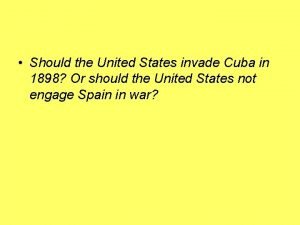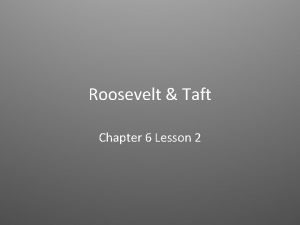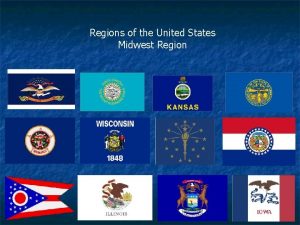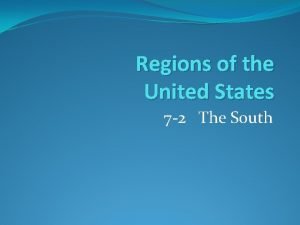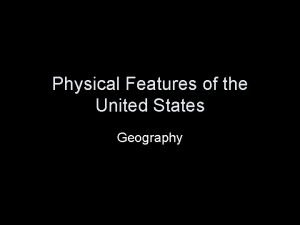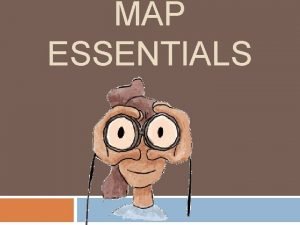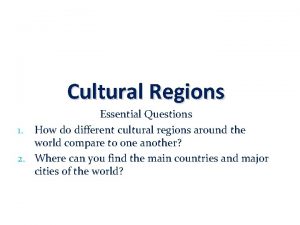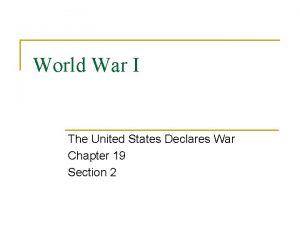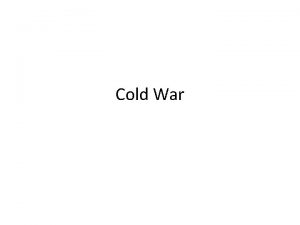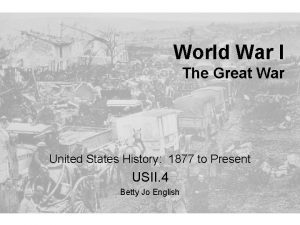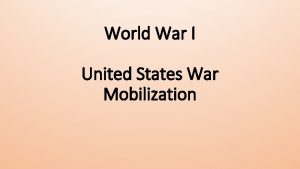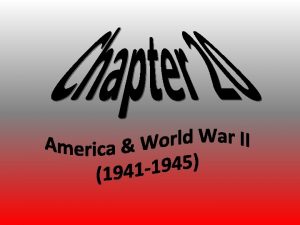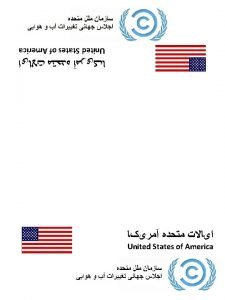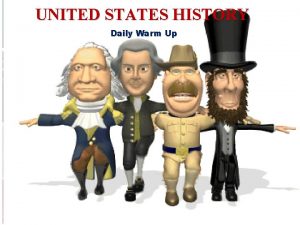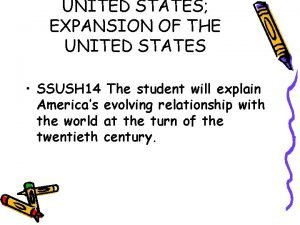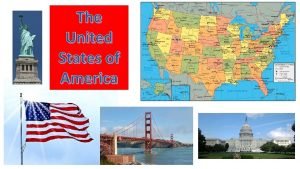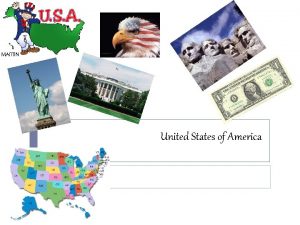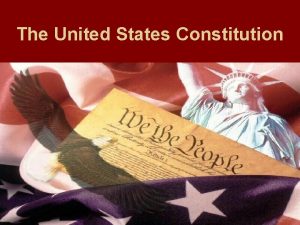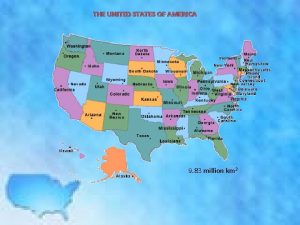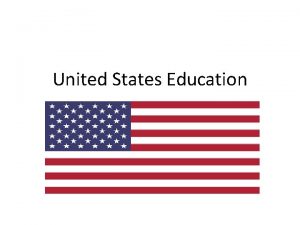World War I Chapter 7 The United States































- Slides: 31

World War I Chapter 7

The United States Enters World War I Chapter 7 Lesson 1

What caused World War I? • Powerful German Empire France lost land • Triple Alliance – Germany, Italy, Austria-Hungary Scared Russians and led them to ally with France (Franco-Russian Alliance, which later became Triple Entente and included Britain) • Alliances led to militarism (strong buildup of forces to protect and scare) • Britain did not want one nation to rule Europe • Build up of German navy led to arms race with Britain



What caused World War I? • Nationalism – intense pride in your country • Imperialism – ruling or controlling of other peoples or nations through annexation, military conquest, or economic domination Different groups began wanting independence (such as Serbs, Bosnians, Croats, & Slovenes)

What causes World War I? • June 1914, assassination of Archduke Franz Ferdinand (heir to Austro. Hungarian throne) in Sarajevo by Gavrilo Princip Serbs hoped to start a war to break Austria-Hungary • July 28, 1914 – Austria-Hungary declared war on Serbia Russia & France entered, due to alliances Germany entered and invaded France through Belgium then Britain entered • New alliances Triple Entente (Allies) – Britain, France, Russia, Italy Central Powers – Germany, Austria-Hungary, Ottoman Empire, Bulgaria


The United States Enters WWI • President Wilson declared neutrality (we won’t take sides) People leaned toward the Allies British propaganda in US • Moving toward war German U-boats sank merchant ships around Britain Germans made agreements with US to stop • Entered war Zimmerman telegram German U-boats sinking all ships (including 6 US ships) Declared war on Germany April 2, 1917


The Home Front Chapter 7 Lesson 2

Organizing the Economy • Wartime Agencies To ensure efficient use of natural resources War Industries Board (WIB) – coordinated production of war materials Food Administration – increasing food production, decreasing consumption Victory gardens Fuel Administration – managed use of coal and oil Daylight savings Shortened work weeks Heatless Mondays • US spent about $32 million by end of WWI


Organizing the Economy • Mobilizing the workforce National War Labor Board (NWLB) Improve wages, 8 -hour workday, unions Women went to work during WWI Minorities went to work Great Migration of African Americans North Mexicans to the Southwest

Organizing the Economy • Shaping public opinion Committee of Public Information (CPI) – “sell” war to Americans Pamphlets, Four-Minute Men, propaganda Espionage The Espionage Act of 1917 Illegal to aid the enemy, give false reports, or interfere with war effort The Sedition Act of 1918 Illegal to speak against the war publicly Racism against German-Americans

Building the Military • Only 200, 000 men at beginning • Volunteer and conscripts Selective Service Act of 1917 – all men 21 -30 had to register for draft 2. 8 million eventually drafted, 2 million of whom volunteered 50, 000 died, over 200, 000 wounded, 60, 000 died from disease Minority groups fought but faced with discrimination • Women join the military Noncombat positions Clerical duties, radio operators, electricians, pharmacists, chemists, photographers Army Nurse Corps – only women to actually serve


Create Your Own Propaganda • 1. You will create your own World War I propaganda • 2. Be unique and creative Do not copy one that already exists Create your own picture and slogan It must relate to WWI

A Bloody Conflict Chapter 7 Lesson 3

Combat in World War I • Europe was devastated • Trench warfare Barbed wires, machine guns, any weapons to kill Stalemate on the Western Front • New technology Poison gas Gas masks Armored tank Zeppelins Airplanes in combat




The Americans Arrive • Nearly 2 million American “doughboys” arrive • Winning the war at sea Ships travel in convoys • Russia leaves the war Vladimir Lenin’s Bolshevik Party = Communism Treaty of Brest-Litovsk on March 18, 1918 Russia gave up Ukraine, Polish and Baltic territories, and Finland to Germany German only fighting on the Western Front

The Americans Arrive • Americans enter combat Only 93 rd Infantry Division, an African American unit, was transferred to the French • Germany’s last offensive was unsuccessful • The Battle of the Argonne Forest Americans opened a hole on German front The Germans began to retreat • The war ends Oct. 1918 – Poland, Hungary, and Czechoslovakia declare independence Austria-Hungarian & Ottoman Empire governments surrendered to Allies Nov. 9, 1918 – Germany became a republic Nov. 11, 1918 – fighting stopped and Germany signed armistice

A Flawed Peace • 27 countries met at a peace conference Treaty of Versailles, with Germany Treaty of Saint-Germain, ending war in Austria-Hungary • The Fourteen Points President Wilson’s peace plan 1 -5: eliminate causes of war through free trade, freedom of the seas, disarmament, an impartial adjustment of colonial claims, and open diplomacy 6 -13: national self-determination 14: League of Nations

A Flawed Peace • The Treaty of Versailles Signed by Germany on June 28, 1919 Germany faced punishment Armed forces reduced & not allowed west of Rhine River Had to pay reparations Owed Allies $33 billion Austrian-Hungary, Russian, German, & Ottoman Empires dismantled League of Nations • The U. S. Senate rejects treaty U. S. Congress & people against League of Nations Formed without U. S.

The War’s Impact Chapter 7 Lesson 4

An Economy in Turmoil • Government agencies removed controls Cost of living – increased People losing jobs • Inflation leads to strikes More than 3, 600 strikes with 4 million workers in 1919 Seattle General Strike General strike – all workers in an area Boston Police Strike 75% walked off job All fired when went back, approved by President Calvin Coolidge Steel Strike


An Economy in Turmoil • Racial unrest 25 race riots in 1919 Biggest riot in Chicago African Americans at a “whites only” beach, sides began throwing stones and an African American teen drowned -> full scale attacks on neighborhoods By end, 38 killed & 500 injured
 United states acquisitions and annexations 1857-1904
United states acquisitions and annexations 1857-1904 Chapter 2 free enterprise in the united states answer key
Chapter 2 free enterprise in the united states answer key Chapter 6 human geography of the united states
Chapter 6 human geography of the united states Chapter 5 lesson 1 physical geography of the united states
Chapter 5 lesson 1 physical geography of the united states Chapter 30 the war to end war
Chapter 30 the war to end war Chapter 30 the war to end war
Chapter 30 the war to end war Was the united states on the axis powers or allied powers?
Was the united states on the axis powers or allied powers? Mediterranean climate in us
Mediterranean climate in us Slave state
Slave state Soccer league hierarchy
Soccer league hierarchy United states v nixon outcome
United states v nixon outcome United states student association
United states student association The united states ought to provide a universal basic income
The united states ought to provide a universal basic income Preamble to the united states constitution
Preamble to the united states constitution The united states in the caribbean 1776 to 1985
The united states in the caribbean 1776 to 1985 Products of the southeast
Products of the southeast Expansion of the united states of america 1607 to 1853 map
Expansion of the united states of america 1607 to 1853 map How did nicholas novikov describe the united states
How did nicholas novikov describe the united states Florida cession date
Florida cession date Author of awake united states
Author of awake united states Mapp v ohio
Mapp v ohio Why did the united states invade cuba in 1898?
Why did the united states invade cuba in 1898? Northern securities vs united states
Northern securities vs united states Midwestern region of the united states
Midwestern region of the united states 7 regions of the united states
7 regions of the united states The united states is the greatest buyer positive degree
The united states is the greatest buyer positive degree United states and canada physical map
United states and canada physical map Physical geography of the usa
Physical geography of the usa 0 degree latitude
0 degree latitude Fifty united states
Fifty united states North central america
North central america United states circus clown (1898-1979)
United states circus clown (1898-1979)
